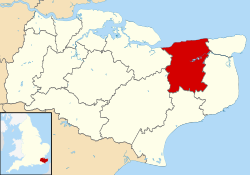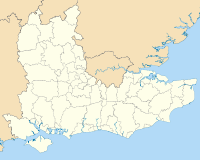|
City of Canterbury
Canterbury (/ˈkæntərbəri/),[2][3] also known as the City of Canterbury, is a local government district with city status in Kent, England. It is named after its largest settlement, Canterbury, where the council is based. The district also includes the towns of Fordwich, Herne Bay and Whitstable, along with numerous villages and surrounding rural areas. Parts of the district lie within the designated Area of Outstanding Natural Beauty of the Kent Downs. The neighbouring districts (clockwise from east) are Thanet, Dover, Folkestone and Hythe, Ashford and Swale, all of which are also in Kent. To the north the district has a coast onto the North Sea. HistoryCanterbury itself was an ancient borough, which had held city status from time immemorial. The earliest known charter was issued by Henry II (reigned 1154–1189). A subsequent charter in 1448 gave the city the right to appoint a mayor. Another in 1461 declared the city to be a county corporate, appointing its own sheriff, making it administratively independent from the surrounding county of Kent.[4] When elected county councils were established in 1889, Canterbury's independence was maintained by making it a county borough, independent from the new Kent County Council.[5] Although administratively independent, Canterbury was still deemed part of Kent for the purposes of lieutenancy.[6] The modern district was created on 1 April 1974 under the Local Government Act 1972, covering the area of four former districts, which were all abolished at the same time:[7]
The Bridge-Blean Rural District entirely surrounded the old city; the urban districts occupied the coastal area to the north.[8] The new district was named Canterbury after its largest settlement.[9] The district is a non-metropolitan district, with Kent County Council providing county-level services to the area. The district was awarded borough status from its creation, allowing the chair of the council to take the title of mayor, continuing Canterbury's series of mayors dating back to 1448.[10] Canterbury's city status was extended to cover the whole of the new borough.[11] In 1988 the position of mayor was given the honorific title of lord mayor.[12] The council continues to appoint a ceremonial sheriff; the sheriff no longer has any judicial functions, but the title is today taken by the deputy chair of the council.[13] Governance
Canterbury City Council provides district-level services. County-level services are provided by Kent County Council.[16] The more rural parts of the district are covered by civil parishes, which form a third tier of local government for their areas.[17] Political controlThe council has been under no overall control since April 2023.[18] Following the May 2023 elections a Labour and Liberal Democrat coalition formed to run the council, led by Labour councillor Alan Baldock.[19] Political control of the council since the 1974 reforms has been as follows:[20]
LeadershipThe role of lord mayor in Canterbury is largely ceremonial. Political leadership is instead provided by the leader of the council (formally the chair of the policy committee prior to 2002). The leaders since 1974 have been:[21]
CompositionsFollowing the 2023 election the composition of the council was:[26]
The next election is due in 2027. ElectionsSince the last full review of boundaries in 2015 the council has comprised 39 councillors representing 21 wards with each ward electing one, two or three councillors. Elections are held every four years.[27] PremisesCouncil meetings are held at Canterbury Guildhall at the corner of St Peter's Place and St Peter's Street, adjoining the Westgate.[28] The building was formerly the Church of the Holy Cross. It had been commissioned by Archbishop Simon Sudbury and was completed before his death in 1381.[29][30] After the church was declared redundant and deconsecrated in 1972, it was acquired by the city council and converted for municipal use: it was officially re-opened by Prince Charles as the council's meeting place on 9 November 1978.[31] The council's main offices are the Council Offices on Military Road, Canterbury, which was built in the 1980s.[32] During 2024 the council plans to vacate Military Road and move its offices to converted parts of the Whitefriars Shopping Centre.[33] GeographyWithin the district are the towns of Herne Bay and Whitstable, which, with the rural parishes and the cathedral city itself, make up the district of the City of Canterbury. There are 27 parishes within the district, as follows:[34]
Swalecliffe is an unparished area within the district. The district is largely rural, with a coastal strip taken up by the almost unbroken spread of seaside towns and beaches from Seasalter, west of Whitstable, to Herne Bay. Between them and the city the hills rise into the wooded area of Blean, south of which the Great Stour flows from its source beyond Ashford. Demography
 Twin townsThe district participates in the Sister Cities programme, with links[38] to Bloomington-Normal, Illinois, and Vladimir, Russia. The Three Towns Association was founded in 1985 on the initiative of three local clergymen to promote person-to-person contact between ordinary people in the UK, the U.S. and Russia. The name was subsequently changed to the Three Cities Association. The Association chose Vladimir as the twin city in Russia because it is the seat of Christianity in that country as Canterbury is the seat of Christianity in England. Vladimir was already twinned with Bloomington-Normal. Among other activities, the Association arranged home-stay exchanges between the two Simon Langton Schools in Canterbury and School No. 23 in Vladimir, where the teaching was conducted in English. Several towns and villages within the City of Canterbury have their own twinning arrangements:[38] see the articles on Canterbury, Whitstable and Herne Bay. See alsoReferences
External links |
|||||||||||||||||||||||||||||||||||||||||||||||||||||||||||||||||||||||||||||||||||||||||||||||||||||||||||||||||||||||||||||||||||||||||||||||||||||||||||||||||||||||||||||||||||||||||||||||||||||||||||||||||||||||||||||||||||||||||||||||||||||||||||||||||||||||||||||||||||||||||||||||||||||||||||||||||||||||||||||||||||||||||||||||||||||||||||||||||||||||||||||||||||||||||||||||||||||||||||||||||||||||||||||||||||||||||||||||||||||||||||







